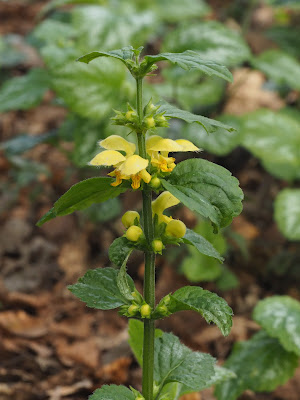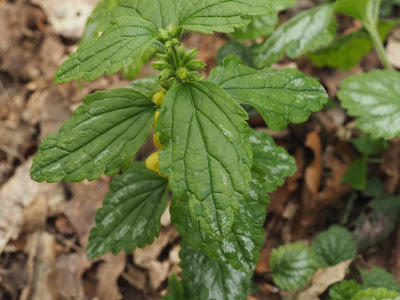Common name: Yellow Archangel
Scientific name: Lamiastrum galeobdolon 花葉野芝麻, 花野芝麻
Genus: Lamiastrum 黃野芝麻屬
Family: Lamiaceae or Labiatae 唇形科, mint or deadnettle or sage family
Remarks: The genus name, Lamiastrum means "Lamium-like" and refers to the nettle-like twigs that are also grown as an ornamental ground cover. The specific name, galeobdolon comes form the fact that crushing leaves of Yellow Archangel would produce unpleasant smell like a weasel 鼬, 黃鼠狼. This species was once classified as Lamium galeobdolon. The difference between Lamiastrum 黃野芝麻屬 and Lamium 野芝麻屬 are as follows:
i/ Lamium 野芝麻屬 : lateral lobes of lower lip are short and obscure.
ii/ Lamiastrum 黃野芝麻屬: lateral lobes of lower lip are well-developed.
Yellow Archangel may well have got its common name from its virtue of not stinging, despite being part of the dead-nettle family, ie. the Lamiaceae or Labiatae.
There are 3 subspecies of Lamiastrum galeobdolon, their differences are as follows:
a/ Ssp. montanum (native): with stems are pubescent on faces as well as angles; equal to or more than 10 flowers per whorl.
b/ Ssp. galeobdolon (native): with stems that are hairy on angles only; equal to or less than 8 flowers per whorl.
c/ Ssp. argentatum (neophyte): has large, conspicuous white blotches on the leaves.
The photos taken below are believed to be the Lamiastrum galeobdolon Ssp. argentatum.
Origin: Neophyte (established after 1500 AD). It has an uncertain origin, perhaps it is a cultivated variant of subsp. montanum. It was probably introduced in the late 1960s and it was first recorded in the wild was in 1974.

















No comments:
Post a Comment